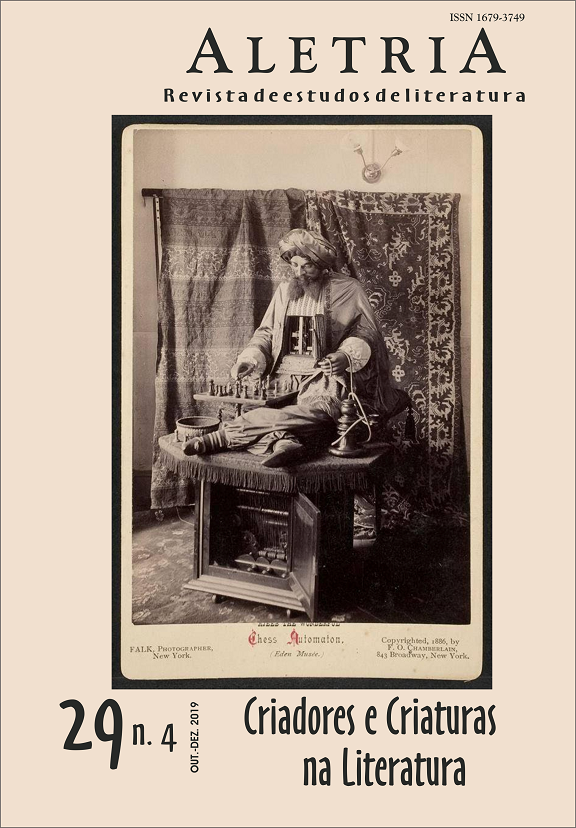Chorality and the World of Parthénoi in Sappho’s Melic Poetry
DOI:
https://doi.org/10.17851/2317-2096.29.4.85-111Keywords:
Sappho, archaic Greek poetry, melic, chorality, maidensAbstract
The article studies the chorality of Sappho’s (Lesbos, c. 630-580 bc) melic (or lyric) poetry, in archaic Greece (c. 800-480 bc), and its relation to the world of parthénoi – the maidens, the unmarried girls – that is one of the main and most visible elements of her surviving corpus of fragments. In order to do so, it focuses on one of the most recently discovered fragments of Sappho, the “Old age song”, published in 2005, for it has provoked a reassessment of the relations between the poet and her community, of her role as leader of the maidens and of the function of chorality in the life of the parthénoi.
Downloads
References
BRASETE, Maria Fernanda. Homoerotismo feminino na lírica grega arcaica. In: FIALHO, Maria do Céu et alii (org.). A sexualidade no mundo antigo. Coimbra: Centro de Estudos Clássicos e Humanísticos U. Coimbra, 2009. p. 289-303.
CALAME, Claude. Les choeurs de jeunes filles en Grèce archaïque. Rome: Ateneo & Bizarri, 1977. 2 v.
CLARK, Christina A. The Gendering of the Body in Alcman’s Partheneion 1. Helios, Lubbock, v. 23, n. 2, p. 143-172, 1996.
DAVIES, Malcom. (ed.). Poetarum melicorum Graecorum fragmenta. Oxford: Clarendon, 1991. v. 1.
FERRARI, Franco. Sappho’s Gift: The Poet and Her Community. Tradução de Benjamin Acosta-Hughes e Laura Prauscello. Ann Arbor: Michigan Classical Press, 2010.
GREENE, Ellen; SKINNER, Marilyn B. (ed.). The New Sappho on Old Age. Washington D.C.: Center for Hellenic Studies, 2009.
HERINGTON, John. Poetry into Drama: Early Tragedy and the Greek Poetic Tradition. Berkeley: University of California Press, 1985.
KATZ, Marylin A. The Divided World of Iliad VI. In: FOLEY, Helen P. (ed.). Reflections of Women in Antiquity. Philadelphia: Gordon and Breach, 1992. p. 19-44.
LADIANOU, Katerina. Female Choruses and Gardens of Nymphs: Visualizing Chorality in Sappho. In: CAZZATO, Vanessa; LARDINOIS, André (ed.). The Look of Lyric: Greek Song and the Visual. Leiden: Brill, 2016. p. 343-369. DOI: https://doi.org/10.1163/9789004314849_015.
LARDINOIS, André. Subject and Circumstance in Sappho’s Poetry. Transactions of the American Philological Association, Baltimore, v. 124, p. 57-84, 1994. DOI: https://doi.org/10.2307/284286.
LEFKOWITZ, Mary. The Last Hours of the Parthenos. In: REEDER, Ellen D. (ed.). Pandora’s Box: Women in Classical Greece. Princeton: University Press, 1995. p. 32-39.
PEPONI, A. Sparta’s Prima Ballerina: Choreia in Alcman’s Second Partheneion (3 PMGF). Classical Quarterly, Cambridge (Inglaterra), v. 57, n. 2, p. 351-362, dez. 2007.
RAGUSA, Giuliana (org. e trad.). Lira grega: antologia de poesia arcaica. São Paulo: Hedra, 2013. DOI: https://doi.org/10.1017/S0009838807000444.
RAGUSA, Giuliana. (org. e trad.). Safo de Lesbos: hino a Afrodite e outros poemas. São Paulo: Hedra, 2011.
RAGUSA, Giuliana. Fragmentos de uma deusa: a representação de Afrodite na lírica de Safo. Campinas: Editora da Unicamp, 2005. [Apoio: Fapesp].
RAGUSA, Giuliana. Heitor e Andrômaca, da festa de bodas à celebração fúnebre: imagens épicas e líricas do casal na Ilíada e em Safo (Fr. 44 Voigt). Calíope, Rio de Janeiro, n. 15, p. 37-64, 2006.
RAGUSA, Giuliana. Lira, mito e erotismo: Afrodite na poesia mélica grega arcaica. Campinas: Editora da Unicamp, 2010. [Apoio: Fapesp].
RAGUSA, Giuliana. Memória, a terra prometida dos poetas: o tema na mélica grega arcaica. Forma Breve, Aveiro, n. 15, p. 143-152, 2018.
RAGUSA, Giuliana; BRUNHARA, Rafael. Paideia na ‘lírica’ grega arcaica: a poesia elegíaca e mélica. Revista Filosofia e Educação, Campinas, n. 9, p. 45-62, 2017. DOI: https://doi.org/10.20396/rfe.v9i1.8648422.
REEDER, Ellen D. Women and Men in Classical Greece. In: ______. (org.). Pandora’s Box: Women in Classical Greece. Princeton: University Press, 1995. p. 20-31.
SCODEL, Ruth. Self-Correction, Spontaneity, and Orality in Archaic Poetry. In: WORTHINGTON, Ian (org.). Voice into Text: Orality and Literacy in Ancient Greece. Leiden: Brill, 1996. p. 59-79. DOI: https://doi.org/10.1163/9789004329836_005.
SEGAL, Phoebe C. The Paradox of Aphrodite. In: KONDOLEON, Christine; SEGAL, Phoebe C. (org.). Aphrodite and the Gods of Love. Boston: MFA Publications, 2011. p. 63-105.
SISSA, Giulia. Greek Virginity. Tradução de Arthur Goldhammer. Cambridge: Harvard University Press, 1990.
SKINNER, Marilyn B. Woman and Language in Archaic Greece, or, Why is Sappho a Woman? In: GREENE, Ellen (ed.). Reading Sappho: Contemporary Approaches. Berkeley: University of California Press, 1996. p. 175-192.
SWIFT, Laura. A. The Hidden Chorus: Echoes of Genre in Tragic Lyric. Oxford: University Press, 2010. DOI: https://doi.org/10.1093/acprof:oso/9780199577842.001.0001.
SWIFT, Laura. Visual Imagery in Parthenaic Song. In: CAZZATO, Vanessa; LARDINOIS, André (ed.). The Look of Lyric: Greek Song and the Visual. Leiden: Brill, 2016. p. 255-287. DOI: https://doi.org/10.1163/9789004314849_012.
VESTRHEIM, Gjert. Alcman fr. 26: A Wish for Fame. Greek, Roman, and Bizantine Studies, Durham, v. 44, p. 5-18, 2004.
VOIGT, Eva-Maria (ed.). Sappho et Alcaeus: Fragmenta. Amsterdam: Athenaeum, Polak & Van Gennep, 1971.
Downloads
Published
How to Cite
Issue
Section
License
Copyright (c) 2019 Giuliana Ragusa (Autor)

This work is licensed under a Creative Commons Attribution 4.0 International License.
Authors who publish with this journal agree to the following terms:Authors retain copyright and grant the journal right of first publication with the work simultaneously licensed under a Creative Commons Attribution Non-Commercial No Derivatives License that allows others to share the work with an acknowledgement of the work's authorship and initial publication in this journal.Authors are able to enter into separate, additional contractual arrangements for the non-exclusive distribution of the journal's published version of the work (e.g., post it to an institutional repository or publish it in a book), with an acknowledgement of its initial publication in this journal.Authors are permitted and encouraged to post their work online (e.g., in institutional repositories or on their website) prior to and during the submission process, as it can lead to productive exchanges, as well as earlier and greater citation of published work (See The Effect of Open Access).





